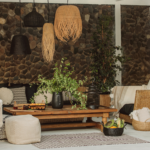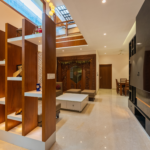In today’s fast-paced urban life, our homes have become more than just places to live. They are personal havens where we find comfort, tranquility, and a sense of belonging. As stress levels rise and our connection to nature diminishes in city settings, a design trend that is gaining popularity is biophilic design. This approach is especially favored in urban Indian homes because it brings the beauty of the outdoors inside.
Biophilic design incorporates natural elements into our living spaces. It improves our health, wellness, and productivity. For homeowners in Indian cities like Bangalore, where space is limited and greenery can be hard to find, adding biophilic architecture to their interiors has become a must-have trend.
So, what exactly is biophilic design?
Biophilic design blends nature with our built environments. It’s not just about adding a few potted plants. It’s a holistic approach that includes natural light, organic materials, water features, and greenery in our homes. This concept recognizes our inherent connection to nature, and biophilic architecture helps bridge the gap between our urban lifestyles and the natural world.
Why are biophilic homes important in Indian cities?
Urban areas in India, such as Bengaluru, Mumbai, and Delhi, face challenges like air pollution, rising temperatures, and a shortage of green spaces. Interior designers in Bangalore are rethinking residential designs to address these problems with natural solutions. A home that features biophilic elements not only feels refreshing but also boosts mental clarity, reduces stress, and supports overall well-being.
Key Biophilic Elements for Urban Indian Homes
Whether you’re living in a cozy apartment or a standalone house, you can easily turn your space into a wellness haven with these biophilic interior ideas:
1. Natural Light and Ventilation
A key aspect of biophilic design is the abundance of natural light. Think big windows, skylights, and light, airy curtains that let the sunshine flood in. Good cross-ventilation keeps the air fresh and reduces the need for artificial cooling, especially important during those warm Bangalore afternoons.
2. Indoor Greenery
Infuse your home with life by adding indoor plants like money plants, peace lilies, snake plants, or bonsai. They not only purify the air but also improve the overall look of your space. If you’re short on floor space, consider vertical gardens or living walls. They’re perfect for compact apartments!
3. Natural Materials and Textures
Bring in materials like wood, stone, clay, jute, and cane in your flooring, furniture, and décor. These earthy textures create a visual link to nature and help establish a calming atmosphere. Many interior designers love using terracotta tiles and bamboo accents to give modern homes a rustic, organic vibe.
4. Water Features
The soothing sound and sight of water can really enhance your space. A small fountain at the entrance, a tabletop water bowl, or even an indoor fish tank can introduce a peaceful element to your home. These features are popular in both traditional Indian décor and modern biophilic designs.
5. Nature-Inspired Patterns and Colors
Opt for colors that mirror the natural world. Think greens, blues, earthy browns, and soft ochres. Wallpapers or upholstery featuring leaf patterns, floral designs, or wave motifs can really strengthen your connection to the outdoors.
6. Biophilic Zoning
Designate wellness zones within your home. A reading nook by the window, a yoga corner surrounded by plants, or a balcony garden can serve as your personal retreat. Interior designers in Bangalore often tailor these spaces to fit each client’s lifestyle while keeping a strong biophilic influence.
Biophilic Design Meets Indian Aesthetics
Merging biophilic design with the charm of traditional Indian architecture is not just a possibility; it is a stunning reality. Elements like courtyards, jaalis (those lovely lattice screens), and verandas are classic features found in our heritage homes. Today’s designers are bringing new life to these ideas by using internal courtyards, open-plan layouts, and channels for natural light in modern residences.
Final Thoughts
As the wellness movement gains momentum, biophilic architecture is moving from being a luxury to a necessity in urban Indian living. Whether you are refreshing your apartment or building a new home, adding biophilic elements can greatly improve your quality of life. If you are considering a home makeover, work with skilled interior designers who understand the essence of biophilic design. In a vibrant city like Bangalore, where nature and modernity blend beautifully, interior designers can create spaces that not only look beautiful but also feel refreshing.





